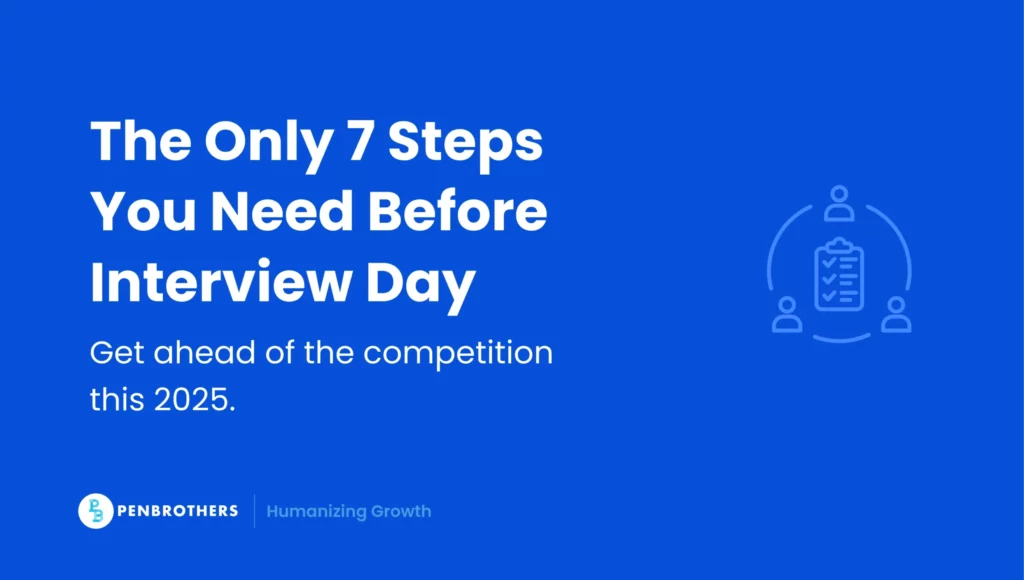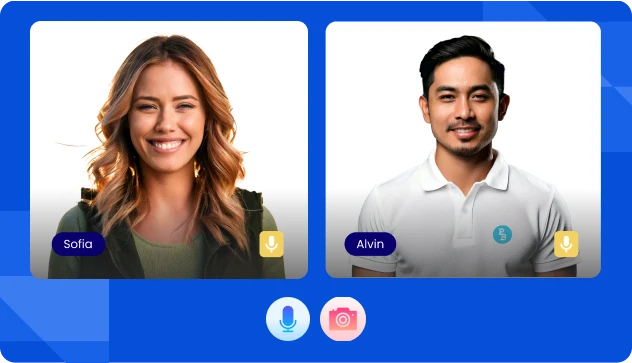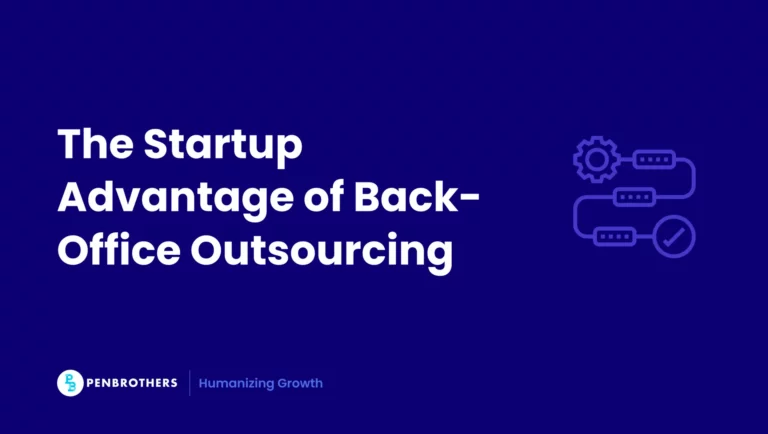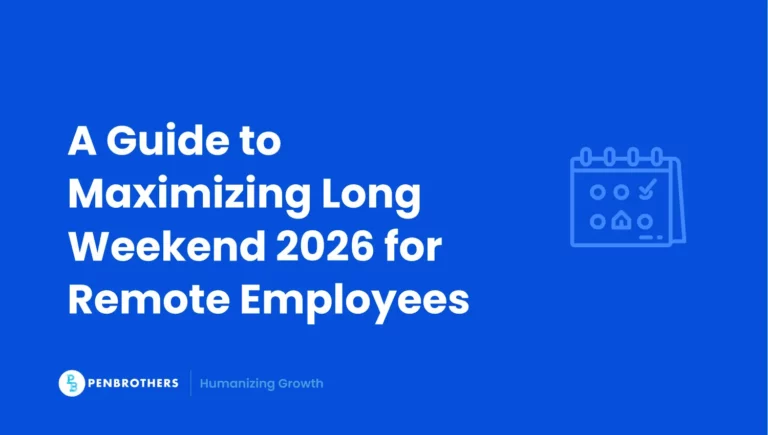Even if you’ve been working for more than five years, interviews can still be nerve-wracking. Whether you’re returning to the workforce after a break, shifting industries, or aiming for a leadership role, the modern hiring landscape demands more than just confidence. Interviews are increasingly structured, competitive, and driven by technology.
In this seven-step guide, we go beyond the basics. You’ll learn strategies rooted in hiring manager insights, behavioral psychology, and emerging digital hiring trends. We will cover how to navigate everything from AI-powered screening and one-way video interviews to advanced behavioral questions, building a comprehensive approach for experienced job seekers looking to stand out.
Key Takeaways
- Preparation is a Strategic 7-Step Process: A successful interview in 2025 requires a comprehensive preparation strategy. This 7-step process includes reviewing the job description, researching the company’s pain points, preparing impactful stories (using STAR, PAR, or CAR), practicing for behavioral questions, and preparing your own strategic questions to ask.
- Use Storytelling Frameworks to Prove Your Impact: Do not just list your skills; prove them with structured stories. The STAR (Situation, Task, Action, Result) method is the gold standard for in-depth answers, while the more concise PAR (Problem, Action, Result) and CAR (Challenge, Action, Result) frameworks are highly effective for phone screens.
- Prepare for a Digital-First Hiring Process: Modern hiring increasingly involves technology. This means your preparation must include a technical check (internet, camera, audio) for virtual interviews and an understanding of asynchronous (one-way) video interviews, where your answers may be screened by AI for keywords.
- Asking Insightful Questions is a Critical Part of the Interview: The questions you ask at the end of an interview are just as important as the answers you give. Prepare strategic, purposeful questions that demonstrate your research and long-term thinking, such as, “What are the biggest challenges your team is facing right now that someone in this role could help solve?”
Step 1: Review the Job Posting and Break Down the Role Requirements
Why it matters: The job description is a cheat sheet for what the company truly needs, if you know how to read between the lines.
- Match Keywords: Align your resume and interview responses with the terms used in the job description. If they say “cross-functional collaboration,” say it back authentically.
- Spot the Implied Needs: Does the role emphasize “fast-paced environment”? That could hint at change management or unstructured workflows.
Example: If the job description mentions “scaling operations,” tailor your pitch to emphasize how you helped streamline a process or lead during a growth phase.
Step 2: Research the Company Beyond the “About Us” Page
Why it matters: In-depth knowledge fuels smarter answers and strategic questions.
- Where to Research: Check recent LinkedIn posts from leadership, read reviews on Glassdoor, dig into product updates, and media coverage.
- What to Look For:
- Mission/vision alignment
- Leadership changes
- Department-specific challenges
- Mission/vision alignment
- Culture indicators (work-life balance, innovation mindset)
Pro Tip: Look for pain points you can solve. If reviews mention disorganized onboarding, prepare a story about how you improved a similar process.
Related:
- Ensure that you do salary research with this 2025 guide.
- Must-Ask Questions for HR in a Job Interview
- Interview Question: Why are You Looking for a New Job?
- Ask Candidates These 15 Data Analyst Interview Questions
Step 3: Prepare Impactful Stories Using STAR, PAR, and CAR
Why it matters: Great stories build trust and prove your capability. Behavioral questions (e.g., “Tell me about a time when…”) are designed to see how you achieve results. Having structured examples ready is essential.
The Gold Standard: The STAR Method
The STAR method remains the most recognized and effective framework for answering behavioral questions in depth. It ensures you provide a complete, logical narrative.
- Situation: Set the scene. What was the context? (e.g., “In my role as project manager, we were facing a potential launch delay…”)
- Task: What was your specific responsibility? (e.g., “…and my task was to realign the engineering and marketing timelines.”)
- Action: What specific steps did you take? (e.g., “I initiated daily 15-minute stand-ups, created a new shared Gantt chart…”)
- Result: What was the measurable outcome? (e.g., “As a result, we identified the key bottleneck and successfully launched on schedule, preventing a projected 15% loss in initial sales.”)
Simpler Alternatives: PAR and CAR
While STAR is ideal for panel interviews, the PAR (Problem, Action, Result) and CAR (Challenge, Action, Result) frameworks are powerful, concise alternatives. They are perfect for phone screens or when you need to make a point quickly.
- Problem/Challenge: What was the issue? (e.g., “Our team’s lead generation was down 20%.”)
- Action: What did you do? (e.g., “I analyzed our funnel, discovered a drop-off at the demo-request stage, and implemented a new A/B test on the landing page form.”)
- Result: What was the impact? (e.g., “The new form increased conversions by 35% in one quarter.”)
Choose Your Story: Align your stories with the job description. Prepare:
- One for leadership or ownership (use STAR or CAR)
- One for problem-solving or innovation (use PAR)
- One for a time you failed or faced conflict (use STAR)
Related: Why the PAR and CAR frameworks get you better job interview answers?
Step 4: Practice for Behavioral and Technical Questions
Why it matters: These questions are make-or-break. Answers are graded on self-awareness, problem-solving, and alignment with the company’s values.
Top Behavioral Questions to Prepare:
- Tell me about a time you had to unlearn something to stay effective in your role. How did you realize it was necessary?
- What’s a recent skill you learned that had no immediate relevance to your role, and how did it end up being valuable anyway?
- What’s your process for decision-making when faced with an unfamiliar challenge and no one to consult?
- Describe a time when a project failed under your watch. What part of that failure do you take personal ownership of?
- Tell me about something you initiated without being asked that ended up helping the team.
- How do you handle stress or high-pressure situations? (This is a very common question. Prepare a specific example using the STAR method—focus on your proactive strategies, like prioritization, time-blocking, or clear communication, not just “I work well under pressure.”)
Simulate Real Conditions:
- Use recording apps like Loom or Zoom to review your delivery.
- Ask a trusted peer or coach to run a mock interview.
Step 5: Get Ready with Purposeful Questions to Guide the Conversation
Why it matters: Great questions show that you’re thinking long-term and strategically.
- High-Impact Questions:
- What are the hidden success metrics for this role that aren’t listed in the job description?
- How does this role directly influence business goals over the next 6–12 months?
- What does your ideal direct report look like in terms of mindset, habits, and communication style?
- What are the hidden success metrics for this role that aren’t listed in the job description?
- Red Flag Detectors:
- When the company says it values [X], how does that actually show up in day-to-day work?
- How does leadership support work-life balance?
- When the company says it values [X], how does that actually show up in day-to-day work?
- Strategic Closer: “What are the biggest challenges your team is facing right now that someone in this role could help solve?”
Step 6: Refine Your Personal Pitch (and Practice Saying It Out Loud)
Why it matters: First impressions still count, especially virtually.
- Your 30–60 Second Pitch:
- Who you are
- What you do best (highlight recent wins)
- What you’re looking for and why
- Who you are
- Adapt It For:
- A formal panel vs. a casual 1-on-1
- In-person vs. remote interviews
- A formal panel vs. a casual 1-on-1
- Non-Verbal Tips:
- Smile and maintain eye contact (look into the camera, not the screen)
- Use open body language
- Practice pacing. Don’t rush through your pitch
- Smile and maintain eye contact (look into the camera, not the screen)
Step 7: Prep for Logistics, Tech, and Post-Interview Follow-Up
Why it matters: Being technically prepared is non-negotiable. A poor connection or lack of preparation can signal a lack of seriousness.
The Virtual & In-Person Checklist:
- Stable Connection: Test your internet speed. Have a backup hotspot ready.
- Tech Check: Test your webcam, audio, and platform (Zoom, Teams, Google Meet).
- Environment: Ensure you are in a quiet, well-lit room with a professional, non-distracting background.
- Non-Verbal Cues: Look into the camera, not at your own image on the screen, to simulate eye contact.
- In-Person Readiness: Confirm the address, plan your travel time, and bring printed copies of your resume.
Prepare for the AI Screener
Many companies now use AI to screen candidates, especially through asynchronous (one-way) video interviews. In this format, you record your answers to pre-set questions without a live interviewer.
- Treat it Seriously: Do not record it in your car or a casual setting. Set up your environment just as you would for a live virtual interview.
- Mind the Keywords: AI screening tools often transcribe your answers to check for keywords from the job description. This analysis by publications like the Harvard Business Review highlights that practicing your alignment with the role’s core competencies is critical.
- Be Clear and Structured: Speak clearly and at a measured pace. Use the STAR or PAR methods to keep your answers structured and easy for the system (and the eventual human reviewer) to follow. You will not get real-time feedback, so clarity is your top priority.
What Are the 10 Most Common Interview Questions?
While behavioral questions dig into your past, you must also prepare for these foundational questions. Hiring managers ask them to quickly understand your motivation, self-awareness, and fit.
- Tell me about yourself. (This is not a life story. It’s your 60-second professional pitch. Use the formula: Present, Past, Future. “Currently, I’m a [Role] at [Company], where I [Key Achievement]. Before that, I [Past Role], and I’m now looking for [Future Goal] that aligns with this position.”)
- What are your strengths? (Choose strengths relevant to the job. Back each one up with a brief, real-world example.)
- What are your weaknesses? (Choose a real, minor weakness. Show self-awareness and explain what steps you are actively taking to improve. For example, “I can be impatient with deadlines, so I’ve adopted a project management tool to track timelines more proactively.”)
- Why do you want to work here? (This tests your research. Connect the company’s mission, product, or recent achievements to your own values and career goals.)
- Why are you leaving your current job? (Be positive or neutral. Focus on the “pull” of the new opportunity, not the “push” of your old job. “I’m looking for a role with a greater focus on [Specific Area], which this position offers.”)
- Where do you see yourself in 5 years? (They want to see ambition and loyalty. Frame your answer around growing with the company.)
- What are your salary expectations? (If possible, give a researched range based on the role, location, and your experience. Providing a range shows flexibility.)
- Tell me about a time you had a conflict with a coworker. (They are testing your collaboration skills. Use the STAR method and focus on the professional resolution, not the drama.)
- Describe a time you failed. (Focus on what you learned and how you applied that lesson to succeed later. They are testing accountability.)
- Do you have any questions for us? (Always say yes. Your questions from Step 5 show your engagement and strategic thinking.)
What Are the Three Golden Rules of an Interview?
Amidst all the specific tactics, three core principles will guide you to success. According to career experts and recruiters, these “golden rules” are non-negotiable.
- Be Prepared: This is the most critical rule. It means you have done your research on the company, its products, and its culture. You must know the job description inside and out, and have your STAR-method stories and insightful questions ready. Preparation is the antidote to anxiety.
- Be Professional: Professionalism is communicated in everything you do. This includes arriving on time (or logging in early for virtual calls), dressing appropriately for the company’s culture, maintaining positive body language, and communicating clearly and respectfully. Never speak negatively about a former employer.
- Be Yourself: Once you have prepared, let your authentic personality show. Companies hire people, not just resumes. Engage in genuine conversation, show enthusiasm, and don’t be afraid to admit if you don’t know something. Authenticity builds trust.
What Should You Do If You Don’t Know the Answer?
It will happen. The key is to not panic or try to invent an answer. A hiring manager values honesty and composure more than a fabricated, incorrect response.
- Don’t Lie: Never invent data or an experience. It’s a major red flag and easy to expose.
- Stay Calm and Pause: Take a breath. It’s acceptable to say, “That’s an excellent question. Let me take a moment to think about that.”
- Ask for Clarification: If the question is ambiguous, ask for more detail. “To make sure I’m answering this correctly, are you asking about [X] or [Y]?”
- Answer a Related Question: If you don’t have a specific example, use a “pivot.” Acknowledge the gap and answer a related question. “I haven’t been in that exact situation, but I did face a similar challenge when [describe related story]. Here is how I handled that…”
Download The 7-Step Interview Preparation Checklist
Related: How to Follow Up on Your Job Interview
Final Thoughts: Start With One Step Today
Preparing for a job interview in 2025 is about more than just rehearsing answers. It’s about understanding your value, anticipating needs, and showing up prepared, digitally and mentally.
If you’re feeling overwhelmed, start with one step: decode a job description or record yourself answering a common question. The key is momentum.
Every well-prepared interview is a step closer to your next opportunity. Ready to put your prep to the test? Explore open roles that align with your goals and skill set, and take that next confident step forward.
Frequently Asked Questions
The first step is to thoroughly review the job posting and break down the requirements. The job description is a “cheat sheet” that tells you exactly what skills and keywords the hiring manager is looking for. You should tailor your answers and examples to align with this language.
They are all frameworks for answering behavioral questions (“Tell me about a time when…”):
STAR (Situation, Task, Action, Result): The most common method, providing a full narrative.
PAR (Problem, Action, Result) / CAR (Challenge, Action, Result): More concise alternatives that are highly effective for senior roles or phone screens, as they jump directly to the problem and the measurable impact.
The three core principles for success are: 1) Be Prepared (research the company, know the job, and have your examples ready), 2) Be Professional (be on time, dress appropriately, and never speak negatively about a past employer), and 3) Be Yourself (be authentic, engaging, and honest).
Do not panic and, most importantly, do not lie or invent an answer. Stay calm, take a moment to think, and be honest. It is perfectly acceptable to say, “I haven’t been in that exact situation, but I did face a similar challenge when…” and then pivot to a related story that demonstrates the skill they are asking about.
This is a type of screening where you record your answers to pre-set questions without a live interviewer present. It is crucial to treat this seriously: use a professional background, speak clearly and at a measured pace, and use structured answers (like the STAR method), as AI may be used to transcribe and scan your responses for keywords.






